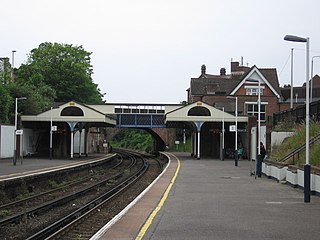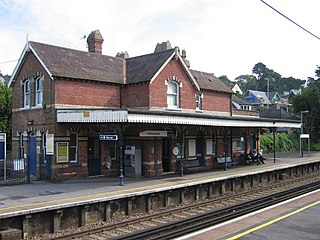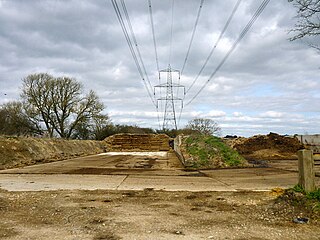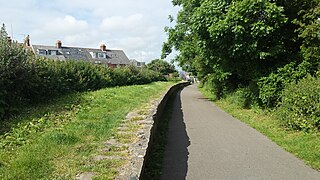
Upwey railway station serves the Broadwey, Upwey and Littlemoor suburbs of Weymouth in Dorset, England. The station is situated on the South West Main Line, 140 miles 31 chains (225.9 km) from London Waterloo and on the Heart of Wessex Line, 166 miles 30 chains (267.8 km) from London Paddington.

Branksome railway station serves the Branksome and Branksome Park areas of Poole in Dorset, England. It is on the South West Main Line, 110 miles 51 chains (178.1 km) down the line from London Waterloo.

Parkstone railway station serves the Parkstone area of Poole in Dorset, England.

Bradford-on-Avon railway station is a railway station on the Wessex Main Line in between Avoncliff and Trowbridge, serving the town of Bradford on Avon, in Wiltshire, England. The station is 9 miles 35 chains (15.2 km) south east of Bath Spa. The station was originally conceived by the Wilts, Somerset and Weymouth Railway, but was not built until after the company was purchased by the Great Western Railway in 1850 and did not open until 1857.

The Bristol and Exeter Railway (B&ER) was an English railway company formed to connect Bristol and Exeter. It was built on the broad gauge and its engineer was Isambard Kingdom Brunel. It opened in stages between 1841 and 1844. It was allied with the Great Western Railway (GWR), which built its main line between London and Bristol, and in time formed part of a through route between London and Cornwall.

Granborough Road railway station was a station serving the village of Granborough, to the north of Quainton in Buckinghamshire, England.
The Dalry and North Johnstone Line was a branch of the Glasgow and South Western Railway (G&SWR) in Renfrewshire and Ayrshire, Scotland, connecting the stations in Elderslie and Dalry via a route running parallel to the existing line built by the Glasgow, Paisley, Kilmarnock and Ayr Railway. This provided additional line capacity for Ayrshire Coast and Kilmarnock services. The loop line was used for passenger services until the mid-1960s, when it was closed by the Beeching Axe. The majority of the line's trackbed has since been absorbed into the Sustrans National Cycle Network.
The Wilts, Somerset and Weymouth Railway (WS&WR) was an early railway company in south-western England. It obtained Parliamentary powers in 1845 to build a railway from near Chippenham in Wiltshire, southward to Salisbury and Weymouth in Dorset. It opened the first part of the network but found it impossible to raise further money and sold its line to the Great Western Railway (GWR) in 1850.
The Bristol and North Somerset Railway was a railway line in the West of England that connected Bristol with Radstock, through Pensford and further into northern Somerset, to allow access to the Somerset Coalfield. The line ran almost due south from Bristol and was 16 miles (26 km) long.
The Bridport Railway was a railway branch line that operated in the county of Dorset in England. It connected Bridport with the main line network at Maiden Newton, and opened on 12 November 1857. It was extended to West Bay in 1884, but the extension was not well used and it closed to passengers in 1930.

The Portland Branch railway refers to a group of lines on the Isle of Portland in the English county of Dorset. The first was the Portland Railway, a tramway with a counterbalanced rope-worked incline. It opened in 1826. It was followed by the Weymouth and Portland Railway, which connected to the main line of the Great Western Railway at Weymouth. It opened in 1865. From the late 1840s until 1872, Portland Breakwater was built, a prodigious construction task that created a very large safe harbour. It was decided to provide a railway connection to the breakwater, which was used as a pier for bunkering ships. This was constructed by the LSWR and the GWR jointly and opened in 1876. The fourth line was the Easton and Church Hope Railway. This line was conceived as a simple descent to bring stone down from quarries to a new jetty at Church Ope, but after their line was authorised in 1867, the Company delayed useful construction, and a change of plan followed, with several Acts of Parliament authorising modifications to the route and extension of time. It finally opened in 1900.
Upwey was a railway station on the Abbotsbury branch railway in the county of Dorset in England.

Melcombe Regis was a station on the Portland Branch Railway in the English county of Dorset. Opened in April 1909, it was sited at the north end of the bridge over Radipole Lake. The station was built to enable Portland branch passengers to go to Weymouth without the need for the branch train to reverse to enter Weymouth railway station. The branch junction was to the north of Weymouth station and faced Dorchester. The station was closed officially, along with the branch, on 3 March 1952. However, the station continued to be used for overflow from the adjacent Weymouth station, particularly on summer Saturdays: regularly until 12 September 1959 and irregularly for a while after that.

Westham Halt was a small railway station in Westham on the Portland Branch Railway in the west of the English county of Dorset.

Rodwell was a small railway station on the Portland Branch Railway in the west of the English county of Dorset.

Sandsfoot Castle Halt was a small railway station on the Portland Branch Railway between Weymouth and Portland in Dorset.

Portesham was a small railway station serving the village of Portesham in the west of the English county of Dorset.

Congresbury railway station was a station located at Congresbury on the Bristol and Exeter Railway's Cheddar Valley line in Somerset and the junction for the Wrington Vale Light Railway to Blagdon.

The Rodwell Trail is a short-distance footpath that runs from Wyke Regis to the town centre of Weymouth in Dorset – a distance of 2¼ miles. The trail, opened in 2000, travels along the former route of the Weymouth and Portland Railway. The section from near Sandsfoot Castle to Ferry Bridge is part of the South West Coast Path. The route follows part of the Jurassic Coast, and Sites of Special Scientific Interest. It is named after a neighbourhood of Weymouth which it passes through.

Ferry Bridge is at the beginning of the causeway to the Isle of Portland, Dorset, England, and is the point at which the Fleet lagoon joins Portland Harbour. It is situated several hundred metres south of Portland's boundary with the village of Wyke Regis, Weymouth. To the west of Ferry Bridge is the start of The Fleet, which is an internationally important nature reserve that extends to Abbotsbury Swannery, while to the east is Portland Harbour. Along the harbour side is Smallmouth Beach. The only road between Portland and the Mainland passes across Ferry Bridge.















